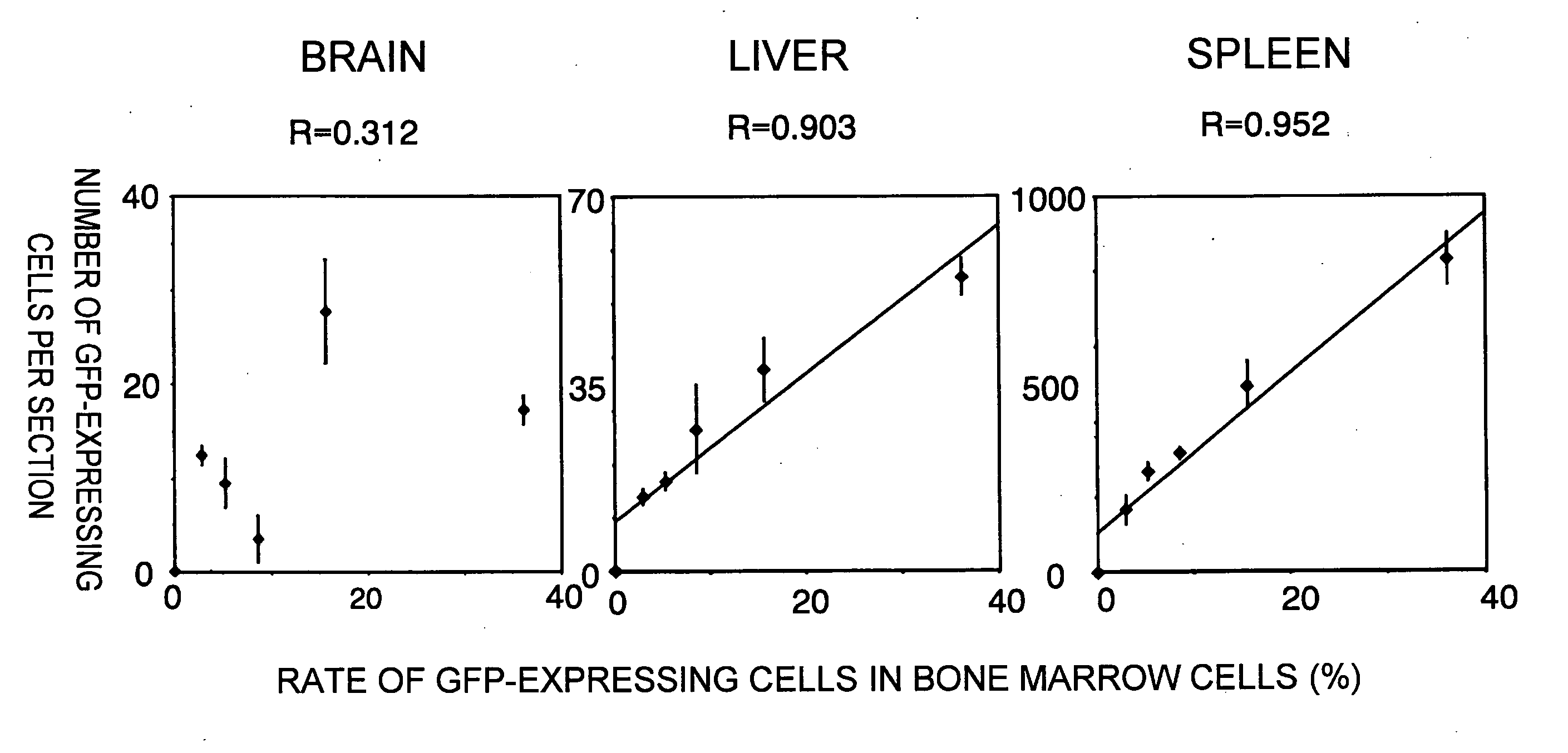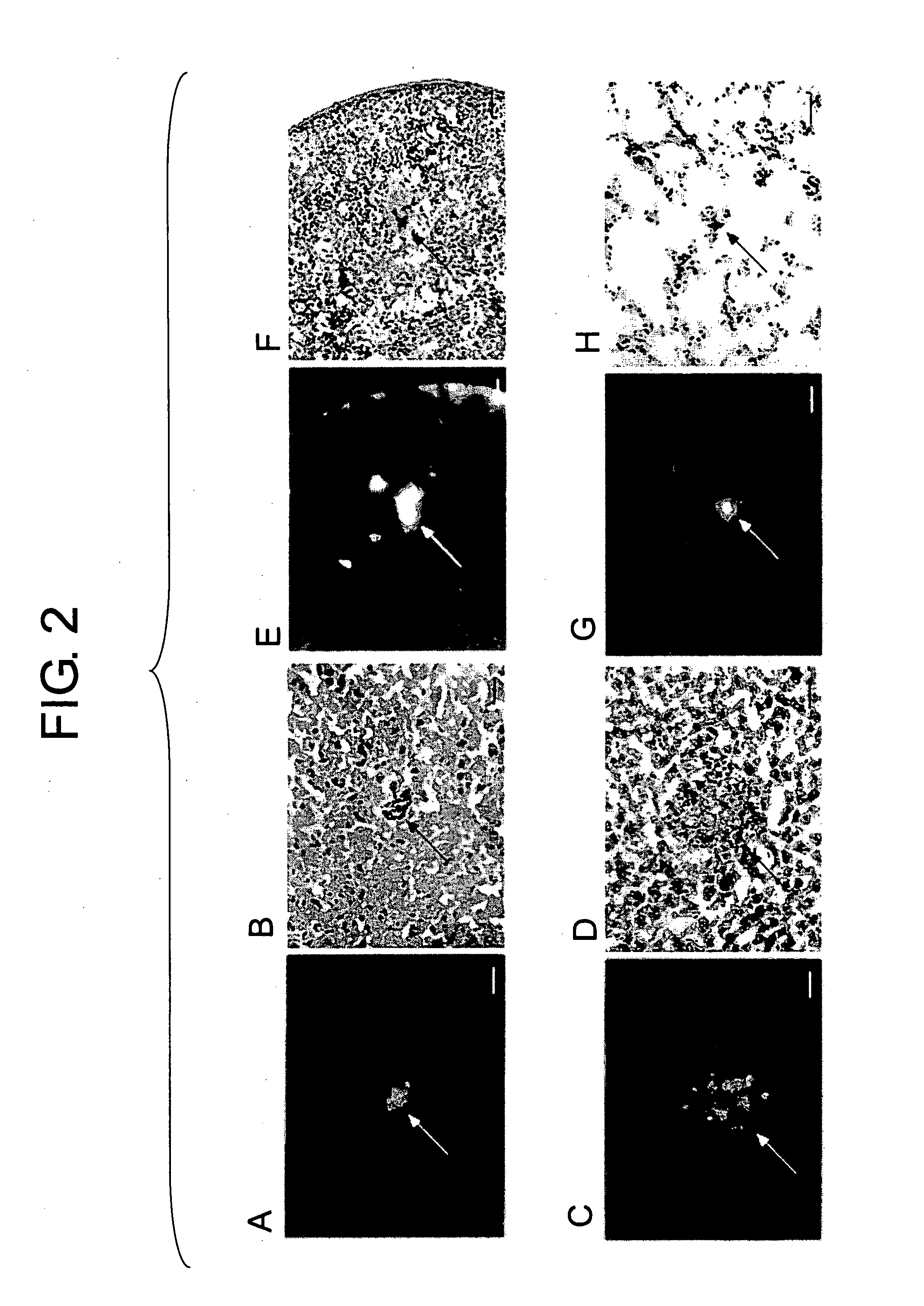Brain-Localizing Bone Marrow Progenitor cells
a bone marrow progenitor cell and brain-localizing technology, applied in the field of cells with brain-localizing activity, can solve the problems of difficult effective brain treatment and disruption of the blood brain barrier
- Summary
- Abstract
- Description
- Claims
- Application Information
AI Technical Summary
Benefits of technology
Problems solved by technology
Method used
Image
Examples
example 1
Effects of Drug Treatment on Host Blood Brain Barrier
[0183] When bone marrow transplantations are performed, in many cases, host bone marrow cells are removed by radiation exposure. This method is suggested to partially disrupt the blood brain barrier or cause neurological deficits. To perform a bone marrow transplantation that was less invasive to the brain, host bone marrow cells were removed using a drug, 5-FU.
[0184] To confirm that the blood brain barrier was undamaged, Evans blue was injected into the tail vein of 5-FU-treated B6 mice, normal B6 mice, and B6 mice that were physically injured using an injection needle, and dye leakage through the blood brain barrier was examined (FIG. 1). As a result, dye leakage was not observed in 5-FU-treated mice, and damage to the blood brain barrier could not be confirmed.
example 2
Correlation between Foreign Cells Found in the Cerebral Parenchyma and those in the Bone Marrow on Day 7 after Transplantation
[0185] Bone marrow cells collected from GFP transgenic mice were transplanted via the tail vein of 5-FU-treated mice. GFP-expressing cells were confirmed in the brain, liver, spleen, and lung on day 7 after transplantation (FIG. 2). When correlations between GFP-expressing cells that translocated to the bone marrow and those that translocated to tissues were examined, a positive correlation was observed in peripheral tissues such as the liver or spleen, whereas no correlation was observed in the brain (FIG. 3).
example 3
Examination of the Stage of Brain-Localization of Cells
[0186] The distributions of GFP-expressing cells in the bone marrow, bloodstream, and tissues were examined over time (FIG. 4). In the bone marrow and blood, the proportion of GFP-expressing cells significantly increased on day 7 after transplantation, and GFP expression had completely disappeared in weeks 3 to 4. GFP-expressing cells that translocated to the liver were virtually undetectable in week 6 after transplantation, and expression had completely disappeared in week 18. In contrast, the GFP-expressing cells that translocated to the brain decreased in number after supply from the bloodstream was terminated; however, expression was still observed in week 18.
[0187] To investigate at what stage GFP-expressing cells translocate into the brain, the brains of transplanted mice were collected over time, and GFP expression was examined using RT-PCR methods (FIG. 5). GFP expression was observed in the brain on days 1 to 2 after ...
PUM
| Property | Measurement | Unit |
|---|---|---|
| fluorescent images | aaaaa | aaaaa |
| time- | aaaaa | aaaaa |
| time | aaaaa | aaaaa |
Abstract
Description
Claims
Application Information
 Login to View More
Login to View More - R&D
- Intellectual Property
- Life Sciences
- Materials
- Tech Scout
- Unparalleled Data Quality
- Higher Quality Content
- 60% Fewer Hallucinations
Browse by: Latest US Patents, China's latest patents, Technical Efficacy Thesaurus, Application Domain, Technology Topic, Popular Technical Reports.
© 2025 PatSnap. All rights reserved.Legal|Privacy policy|Modern Slavery Act Transparency Statement|Sitemap|About US| Contact US: help@patsnap.com



